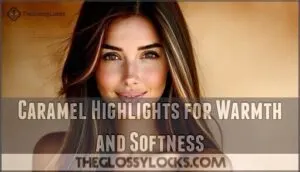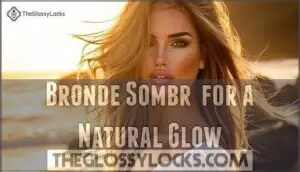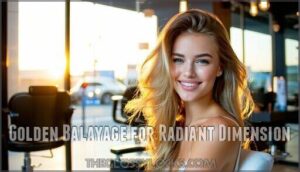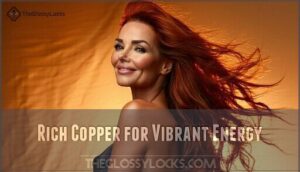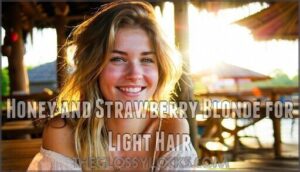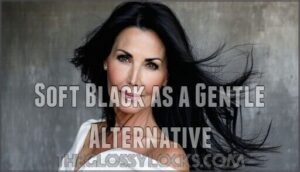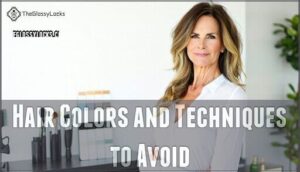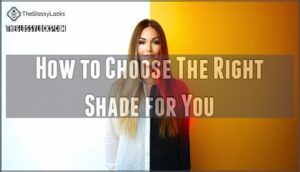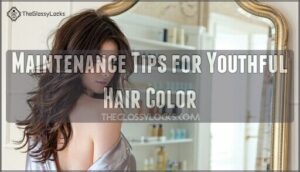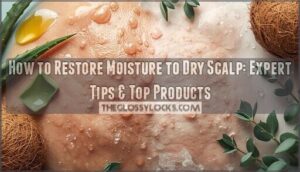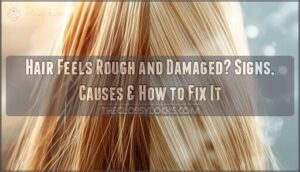This site is supported by our readers. We may earn a commission, at no cost to you, if you purchase through links.
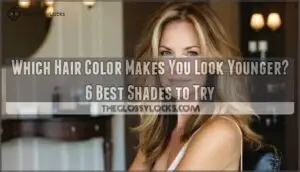
The science is fascinating: lighter, dimensional tones reflect light differently than flat, dark colors, fundamentally creating an optical illusion that smooths skin texture and brightens your complexion. Warm hues with depth—think caramel, honey, or golden balayage—work with your natural coloring to amplify radiance rather than washing you out.
Whether you’re covering silver strands or simply revitalizing your look, strategic color choices transform how young and vibrant you appear, no skincare routine required.
Table Of Contents
- Key Takeaways
- Which Hair Color Makes You Look Younger?
- Best Youthful Hair Colors to Try
- Hair Colors and Techniques to Avoid
- How to Choose The Right Shade for You
- Maintenance Tips for Youthful Hair Color
- Frequently Asked Questions (FAQs)
- How long does a hair color last?
- What are the best products to use for coloring my hair?
- How often should I get my hair professionally colored?
- What are the best practices for maintaining my hair color?
- Are there any natural remedies for restoring hair color?
- Can hair color really make you look younger?
- How often should I change my hair color?
- Does going darker always make you look older?
- Can I achieve youthful hair color at home?
- Conclusion
Key Takeaways
- Lighter, dimensional hair colors with warm tones—like caramel, honey, golden balayage, or soft copper—reflect light in ways that soften facial features, brighten your complexion, and can make you appear up to five years younger by reducing harsh contrast between hair and aging skin.
- Gray hair and very dark, flat colors work against you by creating stark contrasts that emphasize fine lines and dullness, while multi-tonal, warm shades mimic natural light reflection and create an optical illusion that smooths skin texture.
- Your skin’s undertones and eye color dictate which shades will actually flatter you—cool undertones pair with ash or platinum, warm undertones glow with golden or caramel hues, and matching your natural coloring prevents that washed-out look that adds years.
- Low-maintenance techniques like balayage or soft highlights grow out gracefully and require less frequent touch-ups, while sulfate-free products, regular glosses, and deep conditioning treatments protect your investment and keep color vibrant without constant salon visits.
Which Hair Color Makes You Look Younger?
Your hair color can completely shift how others perceive your age, adding years or taking them away depending on the shade you choose. The secret lies in understanding how certain tones interact with your skin, soften facial features, and create that coveted glow that screams vitality.
Let’s break down exactly how color works its magic, what shades deliver that youthful punch, and why your natural coloring matters more than you think.
How Hair Color Impacts Perceived Age
Here’s the thing: your hair color doesn’t just frame your face—it directly influences how old people think you are. Research shows gray hair can make you appear up to five years older, while lighter, softer tones reduce the contrast between your skin and hair, creating a more youthful impression.
This hair color psychology explains why covering gray with natural shades and choosing warm, dimensional hues are powerful antiaging beauty strategies that deliver instant ageless beauty without surgery or injections. Understanding the aging process details can help individuals make informed decisions about their hair color.
Choosing Shades That Enhance Youthfulness
The secret to picking a color that knocks years off your appearance isn’t just about going lighter or darker—it’s about finding shades that bring warmth, dimension, and softness to your complexion.
Think radiant tones like honey, caramel, or golden balayage—these youthful highlights catch light beautifully, creating that antiaging glow you’re after.
Vibrant shades with multiple dimensions trump flat, single-process color every time, because they mimic how natural hair reflects light, instantly boosting your youthful beauty.
The Role of Skin Tone and Eye Color
Your skin’s undertone—whether it’s cool, warm, or neutral—plays a huge role in Hair Color Harmony and which AntiAging Shades will actually flatter you. Cool undertones (think pink or olive hues) pair beautifully with ash tones and platinum, while warm skin glows with golden blonde, caramel, and copper.
Eye Color Matching matters too: research shows blue or gray eyes naturally complement cooler hair shades, while brown eyes shine with deeper, warmer tones. This Color Personalization approach ensures your hair color works with your natural coloring, not against it, giving you that seamless Youthful Beauty.
Understanding your skin tone analysis is essential for choosing the right hair color that complements your skin and reflects your personality.
Best Youthful Hair Colors to Try
Now that you know which factors influence how youthful your hair looks, let’s explore the specific shades that dermatologists and colorists recommend most.
These six colors work with your skin’s natural undertones and facial features to create a softer, more radiant appearance. Each option offers something different, whether you’re looking for subtle warmth or a bolder transformation.
Caramel Highlights for Warmth and Softness
If you’re craving that sun-kissed glow without the damage or commitment, caramel highlights might just be your ticket to turning back the clock a few years. These soft highlights work like magic on brunette shades, melting into your base color with gorgeous dimension that catches light beautifully.
The warmth instantly softens facial features and adds that coveted hair warmth, whether you opt for balayage or traditional weaving techniques.
Bronde Sombré for a Natural Glow
Straddling the line between brunette and blonde, bronde sombré delivers that effortlessly chic, just-back-from-vacation vibe that practically erases years from your appearance.
This sombré technique creates natural highlights that blend seamlessly, giving you dimensional color without harsh lines.
The result? A glow enhancement that works with any skin tone, making bronde hair one of the most universally flattering hair color trends you can try.
Golden Balayage for Radiant Dimension
Think of golden balayage as sunlight brushing through your hair, creating that lit-from-within radiance that takes years off your face while adding the kind of dimensional warmth that makes people wonder what you’re doing differently.
This technique strategically places golden highlights where natural light would hit, creating color depth that mimics how the sun naturally lightens blonde hair over time.
- Face-framing balayage brightens your complexion and softens fine lines around your eyes and forehead
- The hand-painted technique creates radiant locks with flawless blending, avoiding harsh grow-out lines that add years
- Golden tones add hair dimension that makes thinning strands appear fuller and more vibrant
Rich Copper for Vibrant Energy
Copper hair colors carry a warmth that doesn’t just catch the light—they command it, infusing your look with a bold vitality that mirrors the confident energy of someone who’s never felt more alive.
Rich copper tones work wonders on aging skin because they bring out natural rosiness in your complexion, counteracting the sallowness that often comes with time.
These vibrant locks create warm dimension through rich highlights that make thinning hair appear fuller while delivering that coveted youthful glow without looking like you’re trying too hard.
Honey and Strawberry Blonde for Light Hair
Honey and strawberry blonde shades breathe new life into lighter hair by delivering that sun-kissed warmth your skin craves, instantly erasing years without a single surgical intervention. These youthful tones work like magic on fair complexions, adding color dimension through blonde highlights that mimic natural light reflection—the same luminosity you’d have before melanin production slowed down.
Strawberry blonde brings out rosiness in cool-toned skin, while honey blonde flatters warmer undertones, both creating that coveted radiance without harsh hair dye commitment.
Soft Black as a Gentle Alternative
If jet-black hair feels too harsh against aging skin, soft black offers the perfect compromise—rich enough to create striking contrast, yet gentle enough to avoid that unflattering "dyed" look that screams artificial intervention.
This alternative dye delivers black hair trends without the severity, using softening techniques that complement mature complexions.
Soft black benefits include healthier shine and dimension, making it one of the most forgiving hair colors for aging and beauty concerns.
Hair Colors and Techniques to Avoid
While the right color can brighten your complexion and soften your features, the wrong shade or technique can have the opposite effect, drawing attention to fine lines, dullness, or aging skin. Not every trend is going to work in your favor, and some classic choices might actually be adding years to your appearance.
Here’s what you’ll want to avoid if you’re chasing that youthful, radiant glow.
Why Very Dark Colors Can Age You
Very dark hair colors can actually work against you regarding looking youthful, and here’s why. As skin matures, it naturally loses pigment, creating a harsh contrast with jet-black or deep brown shades that emphasizes fine lines and shadows. Studies show faces with very dark hair were perceived as 1.2 times older than those with lighter tones.
Consider these aging hair concerns:
- Increased Color Contrast Theory effects – Dark Hair Effects magnify wrinkles as Aging Skin Tone loses radiance
- Melanin Impact on appearance – 65% of individuals over 40 experience washed-out complexions with overly dark shades
- Limited Youthful Shade Options – Only 12% of mature individuals suit very dark colors without appearing older
Professional colorists recommend softer, multi-tonal approaches for antiaging results. Instead of monochromatic darkness, explore warm highlights that complement your evolving skin tone, honoring both youthful beauty tips and the natural changes your hair color undergoes with time.
Risks of Monochromatic Dyes
Single-shade dyes create a flat, one-dimensional look that can drain vitality from your face, especially as skin tones shift and soften over the years. Natural hair colors feature multiple tones that catch light differently, so ditching flat dyes for dimensional techniques protects your antiaging goals and overall hair care strategy.
Without natural variation, monochromatic hair dye increases Fading Risks and emphasizes Color Damage from Overprocessing. You’re also more vulnerable to Dye Allergies when repeatedly using the same formula.
Avoiding Half-Grey and Grown-Out Roots
Visible roots and patchy grays broadcast neglect rather than elegant silver, making you look older than a fully gray or freshly colored head ever could. Keep your hairline sharp with these strategies:
- Root Touchups every 3–4 weeks prevent stark demarcation lines
- Grey Blending techniques soften the shift instead of harsh color treatment
- Color Refresh glosses revive fading between full dye sessions
- Hairline Maintenance focuses product where aging hair shows first
- Root Concealers offer instant camouflage between salon visits
Overdoing Color or Bleaching
Too much bleach or chemical dye creates the kind of fried, straw-like texture that screams "damage" and instantly adds years, no matter how trendy the shade. Overprocessing strips melanin and moisture, leaving you with brittle strands prone to breakage—a telltale sign of aging hair.
Instead, embrace balayage or highlights that require fewer bleach sessions, protect your color with toner adjustments between appointments, and invest in anti-aging beauty tips like deep conditioning to combat fading issues and color damage.
Flattering Vs. Unflattering Hair Partings
While damaged hair certainly ages you, the wrong parting can quietly work against you too, casting unflattering shadows that emphasize lines, dull your complexion, or make thinning areas more obvious.
A deep side part with side-swept bangs creates facial symmetry and softens features, while a harsh center part can highlight asymmetry.
Experiment with hair parting styles that complement your hair texture and face shape—it’s simple anti-aging advice that amplifies even the most youthful hair color.
How to Choose The Right Shade for You
Choosing the right hair color isn’t about following trends, it’s about understanding what works with your natural coloring. Your skin tone, undertones, eye color, and even hair texture all play a role in finding a shade that genuinely makes you look refreshed and youthful.
Here’s how to narrow down your best options and make a choice you’ll love.
Matching Hair Color to Skin Tone
Your skin tone is the compass that guides you to your most flattering hair color—ignore it, and you risk looking washed out or aged. Skin Tone Analysis starts with identifying whether you’re warm, cool, or neutral, something 79% of stylists assess before mixing color.
Check your wrist veins: greenish points to warm undertones that glow with golden blondes and caramel, while blue or purple veins signal cool undertones that pop with ash tones and platinum.
This Color Matching approach, rooted in Undertone Theory and Hair Color Science, creates Tailored Palettes that improve your complexion rather than fighting it.
Assessing Undertones and Eye Color
Your eye color isn’t just a pretty detail—it’s actually a pigmentation clue that reveals which hair shades will make your features sing instead of disappear. Blue or gray eyes harmonize with cool ash tones, while warm caramels and golden highlights enhance brown or green eyes.
This Eye Color Matching strategy, combined with Undertone Determination, creates Tailored Shades that brighten your complexion instead of washing it out—Color Palette Creation at its smartest.
Considering Hair Texture and Thickness
Fine hair drinks up color differently than thick strands do, and ignoring that difference can leave you with a shade that either fades too fast or sits too heavy on your head. Here’s how Texture Analysis guides smarter hair color choices:
- Hair Porosity affects how brunette hair absorbs dye—high porosity grabs color fast but releases it quickly.
- Hair Density determines whether multi-dimensional techniques add flattering depth or overwhelming bulk.
- Fine strands benefit from Volume Boosters like strategic highlights that create movement.
- Thick hair manages richer, deeper tones without looking weighed down, supporting overall hair health through gentler hair care and styling.
Seeking Professional Color Consultations
A colorist reads your hair the way a dermatologist reads your skin—looking beyond the surface to spot what’ll actually work with your unique biology, undertones, and lifestyle. During a consultation, they’ll conduct Color Analysis and Hair Typing to recommend Tailored Shades that complement your complexion.
Many salons now offer Virtual Consults, making expert cosmetic advice accessible before you commit to hair dye and treatment—smart beauty tips that protect both your wallet and your strands.
Maintenance Tips for Youthful Hair Color
Getting the color right is just the first step—keeping it vibrant and youthful requires some smart upkeep. Your hair color needs consistent care to maintain that fresh-from-the-salon glow without constant touch-ups.
Here’s how to protect your investment and keep your shade looking radiant for weeks to come.
Low-Maintenance Coloring Techniques
Let’s be honest—nobody wants to live in a salon chair, but that doesn’t mean you have to sacrifice color that takes years off your face. The balayage method and soft balayage create natural-looking hair highlights that grow out gracefully, while dimensional coloring adds depth without constant root touchups.
Hair glossing between appointments keeps your hair color vibrant, and color depositing treatments refresh faded tones without harsh hair dye commitment.
Using Color-Protecting Hair Products
Once you’ve invested in gorgeous, age-defying color, the right products become your insurance policy against fading, brassiness, and that dull, washed-out look that adds years back on. Color preservation starts with sulfate-free shampoos that won’t strip your hair color faster than a beach vacation.
Look for these product ingredients that protect coloring hair:
- UV filters shield hair highlights from sun-induced fade
- Keratin and proteins lock in hair moisture and vibrancy
- Purple or blue pigments neutralize unwanted warm tones
Quality hair care products extend the life of your investment markedly.
Regular Trims and Nourishing Treatments
Beyond great products, healthy hair needs regular upkeep to prevent split ends from broadcasting your age louder than any gray root ever could. Schedule hair trims every 6-8 weeks to maintain hair texture and prevent breakage that dulls your color.
Between cuts, use nourishing masks and hair oils weekly—they’re basically anti-aging beauty tips for your strands.
Don’t skip scalp care either; a healthy foundation means stronger, shinier hair that holds color better.
Managing Gray Hair With Glosses and Toners
Gray hair doesn’t have to mean giving up on color—glosses and toners can refresh silver strands or subtly shift them toward warmer, more flattering hues without harsh commitment.
A hair gloss boosts shine and neutralizes brassy tones that age you, while toners correct unwanted yellow or gray undertones.
Apply toner every few weeks for vibrant gray coverage tips that keep aging hair looking intentional, not neglected—it’s color correction without the damage.
Lifestyle Habits for Healthy, Youthful Hair
What you put in your body—and how you treat your scalp—matters just as much as the color you paint on top. Boost water intake and follow a balanced diet rich in biotin to support hair health and texture from within.
Use hair oils for a healthy scalp, consider hair supplements for anti-aging advice, and embrace consistent hair care and maintenance—these youthful beauty tips keep your youthful hair colors vibrant, lustrous, and truly striking.
Frequently Asked Questions (FAQs)
How long does a hair color last?
Depending on dye type and hair care maintenance, most hair color lasts four to eight weeks before fading factors like washing and sun exposure kick in.
Permanent dye offers better durability than semi-permanent options, though hair regrowth eventually demands touch-ups regardless of color longevity.
What are the best products to use for coloring my hair?
To color hair at home, look for quality permanent or semi-permanent hair dye formulas with built-in conditioner choices.
Professional-grade toner products help neutralize brassiness, while sulfate-free shampoo options and color-safe conditioners protect your investment and prevent premature fading.
How often should I get my hair professionally colored?
Don’t put all your eggs in one basket with color frequency—timing matters. Generally, you’ll need salon visits every four to six weeks for root touchups and color maintenance.
Hair regrowth shows faster with darker shades, while aging hair and techniques like balayage stretch time between appointments, making hair coloring and styling more manageable.
What are the best practices for maintaining my hair color?
Your hair color investment deserves protection. Use sulfate-free, Color Preservation shampoos, and schedule Root Touchups every six weeks. Apply glosses for Shade Enhancement.
Deep conditioning is essential for Hair Moisturizing. Embrace low-maintenance Hair Coloring and Styling techniques that support AntiAging Beauty Tips.
Are there any natural remedies for restoring hair color?
Instead of relying on dye, some people turn to herbal rinses like sage or rosemary, which temporarily darken strands.
Others explore Ayurvedic treatments, vitamin supplements rich in amino acids, and antioxidant-packed diets to support pigment production from within.
Can hair color really make you look younger?
Absolutely—your hair color directly influences color perception and how others read aging signs on your face.
The right youthful shades soften features, while harsh tones exaggerate wrinkles and dullness, making this one of the smartest anti-aging moves you can make.
How often should I change my hair color?
Think of hair color like a wardrobe refresh—it needs updating, but timing matters. Root maintenance and Fading Prevention depend on your Hair Growth Cycles, usually every 4-6 weeks for roots, though low-maintenance techniques extend this to seasonal updates, preserving vibrancy while aging gracefully.
Does going darker always make you look older?
Not necessarily—going darker can work if you choose the right shade. Very dark, flat colors like jet-black can create harsh contrast against aging skin, emphasizing fine lines and dullness.
However, soft black or rich chocolate with subtle dimension adds depth without that aging effect, especially when paired with your natural skin tone.
Can I achieve youthful hair color at home?
You can refresh your look without a professional visit, but at-home coloring has limits. Hair dye kits work well for home maintenance tips like root touch-ups or all-over color, though DIY highlights and color correction often need salon expertise to avoid aging hair with uneven tones.
Conclusion
Like a Renaissance portrait where light and shadow sculpted youth, which hair color makes you look younger depends on contrast, dimension, and warmth.
Caramel highlights, golden balayage, and honey tones don’t just flatter—they reflect light strategically, softening lines and reviving your complexion.
Skip harsh blacks and flat grays; embrace depth instead. Your colorist isn’t just mixing pigment—they’re orchestrating an optical symphony that turns back time without a single injection.

